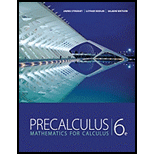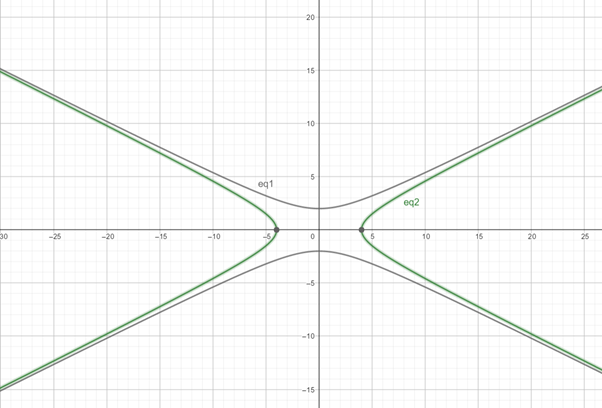
a.
To show:that the hyperbolas are conjugate and sketch their graphs.
a.
Explanation of Solution
Given information:
The hyperbola equation is
Concept used:
Two hyperbolas are conjugate if they are in the following form,
Proof:
first write the hyperbolas in the standard form,
From the above equations it is observed that both hyperbolas are conjugate.
First write the equation in a standard form of hyperbola,
Because the
Since here
Vertices: because the
The vertices on the x-axis are
Now substitute
So vertices are
Foci: because the
So foci are
Now substitute
So, the foci are
Asymptote: for the positive
Now substitute
So asymptotes are
Use the above information together with some additional values which is show in table below
To sketch the graph,
| x | y |
| -4 | 0 |
| -5 | 3.20 |
| 5 | 3.20 |
| 4 | 0 |
First write the equation in a standard form of hyperbola,
Because the
Since here
Vertices: because the
The vertices on the y-axis are
Now substitute
So vertices are
Foci: because the
So foci are
Now substitute
So, the foci are
Asymptote: for the positive
Now substitute
So asymptotes are
Use the above information together with some additional values which is show in table below
To sketch the graph,
| x | y |
| -2 | 2.23 |
| -1 | 2.06 |
| 1 | 2.06 |
| 2 | 2.23 |
The graph is obtained as,

b.
To find: the common part in hyperbolas.
b.
Answer to Problem 44E
The common part of hyperbolas is the value of c.
Explanation of Solution
The common part of hyperbolas is the value of c.
Given information:
The hyperbola equation is
Calculation: from the part(a) it can be observed that the value of c is common in the hyperbolas.
c.
To show: that the relationship between the pair of conjugate hyperbolas.
c.
Explanation of Solution
Given information:
The hyperbola equation is
from the part (b) and part (a) it can be observed that,
to have a pair of conjugate hyperbolas, their c value will be same and one of the hyperbola has horizontal transverse axis and another one has to vertical transverse axis.
Chapter 11 Solutions
Precalculus: Mathematics for Calculus - 6th Edition
 Calculus: Early TranscendentalsCalculusISBN:9781285741550Author:James StewartPublisher:Cengage Learning
Calculus: Early TranscendentalsCalculusISBN:9781285741550Author:James StewartPublisher:Cengage Learning Thomas' Calculus (14th Edition)CalculusISBN:9780134438986Author:Joel R. Hass, Christopher E. Heil, Maurice D. WeirPublisher:PEARSON
Thomas' Calculus (14th Edition)CalculusISBN:9780134438986Author:Joel R. Hass, Christopher E. Heil, Maurice D. WeirPublisher:PEARSON Calculus: Early Transcendentals (3rd Edition)CalculusISBN:9780134763644Author:William L. Briggs, Lyle Cochran, Bernard Gillett, Eric SchulzPublisher:PEARSON
Calculus: Early Transcendentals (3rd Edition)CalculusISBN:9780134763644Author:William L. Briggs, Lyle Cochran, Bernard Gillett, Eric SchulzPublisher:PEARSON Calculus: Early TranscendentalsCalculusISBN:9781319050740Author:Jon Rogawski, Colin Adams, Robert FranzosaPublisher:W. H. Freeman
Calculus: Early TranscendentalsCalculusISBN:9781319050740Author:Jon Rogawski, Colin Adams, Robert FranzosaPublisher:W. H. Freeman
 Calculus: Early Transcendental FunctionsCalculusISBN:9781337552516Author:Ron Larson, Bruce H. EdwardsPublisher:Cengage Learning
Calculus: Early Transcendental FunctionsCalculusISBN:9781337552516Author:Ron Larson, Bruce H. EdwardsPublisher:Cengage Learning





